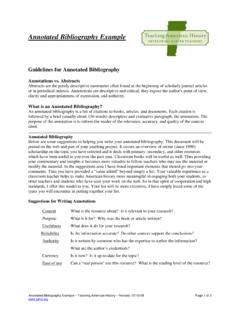Transcription of Annotated Bibliography of Notable LGBT Health Disparity ...
1 Page 1 of 30 Annotated Bibliography of Notable lgbt Health Disparity studies Compiled on 7/12/10 by the Network for lgbt Tobacco Control through input from the following lgbt Health researchers: Alicia Matthews, , University of Illinois at Chicago Deborah Bowen, , Boston University Don Operario, , Brown University Emilia Lombardi, University of Pittsburgh Francisco Buchting, , ETR Associates Joseph Lee, , CPH, University of North Carolina Judith Bradford, , The Fenway Institute Ron Stall, , University of Pittsburgh Scout, , The Fenway Institute Tonda Hughes, , University of Illinois at Chicago Assistance was provided via the resources of the lgbt Population Research Center. Additional thanks to Dwyer Deighan. Page 2 of 30 Access to Health Services Bauer, G. R., R. Hammond, et al. (2009). ""I don't think this is theoretical; this is our lives": how erasure impacts Health care for transgender people." J Assoc Nurses AIDS Care 20(5): 348-61. For people who are transgender, transsexual, or transitioned (trans), access to primary, emergency, and transition-related Health care is often problematic.
2 Results from Phase I of the Trans PULSE Project, a community-based research project in Ontario, Canada, are presented. Based on qualitative data from focus groups with 85 trans community members, a theoretical framework describing how erasure functions to impact experiences interacting with the Health care system was developed. Two key sites of erasure were identified: informational erasure and institutional erasure. How these processes work in a mutually reinforcing manner to erase trans individuals and communities and produce a system in which a trans patient or client is seen as an anomaly is shown. Thus, the impetus often falls on trans individuals to attempt to remedy systematic deficiencies. The concept of cisnormativity is introduced to aid in explaining the pervasiveness of trans erasure. Strategies for change are identified. Coker, T. R., S. B. Austin, et al. (2010). "The Health and Health care of lesbian, gay, and bisexual adolescents." Annu Rev Public Health 31: 457-77.
3 Adolescents face a variety of challenges in their transition to adulthood; lesbian, gay, and bisexual adolescents face these typical challenges as well as additional challenges that are related to the social stigma of their sexual orientation. For some lesbian, gay, and bisexual adolescents, this stigma may induce psychosocial stress, leading to increased Health risk behaviors and poorer Health outcomes. In this article, we review data on the Health and Health care of LGB adolescents. We examine Health indicators and Health risks for LGB youth, including substance use, eating disorders, suicidality, risky sexual behaviors, violence exposure and victimization, and homelessness. We also examine Health care provision and utilization for LGB youth. Lastly, we discuss ways in which researchers and clinicians can improve LGB adolescent Health and Health care. Heck, J. E., R. L. Sell, et al. (2006). " Health care access among individuals involved in same-sex relationships.
4 " American Journal of Public Health 96(6): 1111-8. OBJECTIVES: We used data from the National Health Interview Survey to compare Health care access among individuals involved in same-sex versus opposite-sex relationships. METHODS: We conducted descriptive and logistic regression analyses from pooled data on 614 individuals in same-sex relationships and 93418 individuals in opposite-sex relationships. RESULTS: Women in same-sex Page 3 of 30 relationships (adjusted odds ratio [OR]= ; 95% confidence interval [CI]= , ) were significantly less likely than women in opposite-sex relationships to have Health insurance coverage, to have seen a medical provider in the previous 12 months (OR= ; 95% CI= , ), and to have a usual source of Health care (OR= ; 95% CI= , ); they were more likely to have unmet medical needs as a result of cost issues (OR= ; 95% CI= , ). In contrast, Health care access among men in same-sex relationships was equivalent to or greater than that among men in opposite-sex relationships.
5 CONCLUSIONS: In this study involving a nationwide probability sample, we found some important differences in access to Health care between individuals in same-sex and opposite-sex relationships, particularly women. Cancer Boehmer, U. and P. Case (2004). "Physicians don't ask, some patients tell: Disclosure of sexual orientation among women with breast carcinoma." American Cancer Society 101(8): 1882-1889. Bowen, D. J., U. Boehmer, et al. (2007). Cancer and sexual minority women. The Health of Sexual Minorities: Public Health Perspectives on Lesbian, Gay, Bisexual and Transgender Populations. I. H. Meyer and M. E. Northridge. New York, Springer: 523-538. Cochran, S. D., V. M. Mays, et al. (2001). "Cancer-related risk indicators and preventive screening behaviors among lesbians and bisexual women." American Journal of Public Health 91(4): 591-7. OBJECTIVES: This study examined whether lesbians are at increased risk for certain cancers as a result of an accumulation of behavioral risk factors and difficulties in accessing Health care.
6 METHODS: Prevalence estimates of behavioral risk factors (nulliparity, obesity, smoking, and alcohol use), cancer screening behaviors, and self-reported breast cancer histories derived from 7 independently conducted surveys of lesbians/bisexual women (n = 11,876) were compared with national estimates for women. RESULTS: In comparison with adjusted estimates for the US female population, lesbians/bisexual women exhibited greater prevalence rates of obesity, alcohol use, and tobacco use and lower rates of parity and birth control pill use. These women were also less likely to have Health insurance coverage or to have had a recent pelvic examination or mammogram. Self-reported histories of breast cancer, however, did not differ from adjusted US female population estimates. CONCLUSIONS: Lesbians and bisexual women differ from heterosexual women in patterns of Health risk. These women would be expected to be at especially greater risk for chronic diseases linked to smoking and obesity.
7 Page 4 of 30 General (2001). Healthy People 2010 lgbt Companion Document. San Francisco, CA, Gay and Lesbian Medical Association: 481. < > Accessed on July 12, 2010. Aaron, D. J., N. Markovic, et al. (2001). "Behavioral risk factors for disease and preventive Health practices among lesbians." American Journal of Public Health 91(6): 972-5. OBJECTIVES: This study compared the prevalence of Health behaviors among lesbians and in the general population of women. METHODS: We used a cross-sectional community-based survey of 1010 self-identified lesbians 18 years or older. RESULTS: Compared with the general population of women, lesbians were more likely to report cigarette use, alcohol use, and heavy alcohol use. A higher percentage of lesbians were categorized as overweight, and lesbians were more likely to participate in vigorous physical activity. They were less likely to report having had a Papanicolaou test within the past 2 years but more likely to report ever having had a mammogram.
8 CONCLUSIONS: While there may be differences in Health behaviors between lesbians and the general population of women, how these differences influence the risk of subsequent disease is unknown. Boehmer, U. (2002). "Twenty years of public Health research: inclusion of lesbian, gay, bisexual, and transgender populations." American Journal of Public Health 92(7): 1125-30. OBJECTIVES: This study determined to what extent lesbian, gay, bisexual, and transgender ( lgbt ) populations have been studied over the past 20 years of public Health research. METHODS: From MEDLINE English-language articles on human subjects published between 1980 and 1999, I identified articles that included lgbt individuals. The abstracts were analyzed with a coding procedure that categorized the content by topic, sexual orientation, and race/ethnicity. RESULTS: lgbt issues were addressed by 3777 articles, or of all Medline articles; 61% of the articles were disease-specific, and 85% omitted reference to race/ethnicity.
9 Research unrelated to sexually transmitted diseases addressed lesbians and gay men with similar frequency, whereas bisexual persons were less frequently considered, and the least amount of research focused on transgender individuals. CONCLUSIONS: Findings supported that lgbt issues have been neglected by public Health research and that research unrelated to sexually transmitted diseases is lacking. Bowen, D. J., J. Bradford, et al. (2006). "Comparing sexual minority status across sampling methods and populations." Women and Health 44(2): 121-34. Page 5 of 30 The Health of sexual minority women (SMW) has recently received research attention. Previous research into the Health of SMW ( , lesbians, bisexuals, transgendered women) used a mixture of sampling methods, many of which were poorly documented and difficult to understand. The results of these previous studies do not present a consistent pattern of findings, possibly due to differences in sampling methods. The present study compared the characteristics of SMWacross four survey sampling methods, three in the same geographic area.
10 Differences were found among groups of SMW by sampling method, including in demographic data ( , level of education) and personal Health data ( , rates of regular mammography screening). These findings provided a possible explanation for the variety of findings in the published literature and identified rigorous sampling methods that can be used in future research. Cochran, S. D. and V. M. Mays (2007). "Physical Health complaints among lesbians, gay men, and bisexual and homosexually experienced heterosexual individuals: results from the California Quality of Life Survey." American Journal of Public Health 97(11): 2048-55. OBJECTIVES: We examined evidence that minority sexual orientation is associated with more-frequent reports of physical Health complaints. We also investigated the possible role of HIV infection among gay men and higher rates of psychological distress among lesbians, gay men, and bisexually and homosexually experienced heterosexual individuals in generating these Health disparities.







![Abstract arXiv:1707.01836v1 [cs.CV] 6 Jul 2017](/cache/preview/4/1/7/c/3/c/f/5/thumb-417c3cf524207c81cbb20aac762ce5b4.jpg)